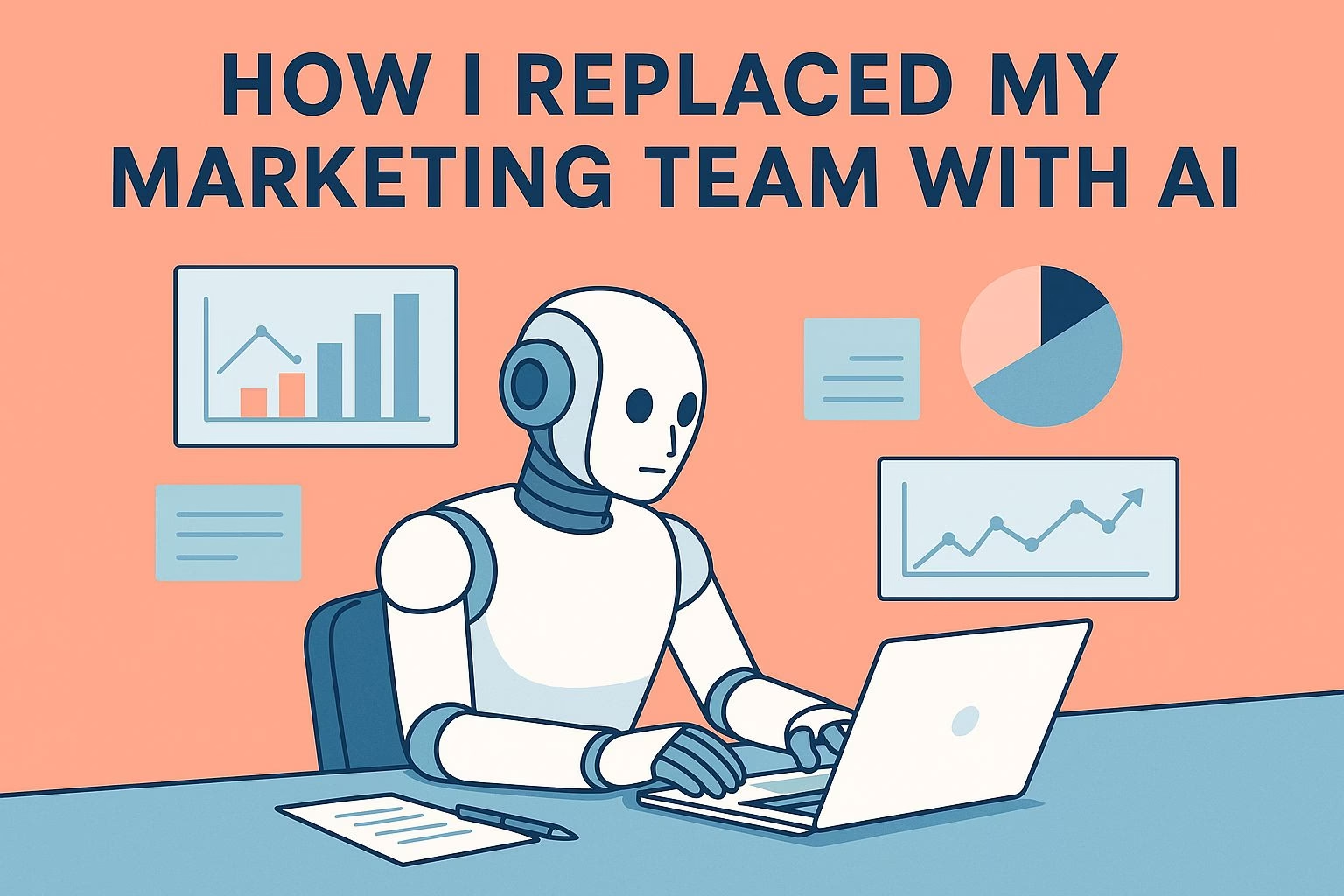I Replaced My Entire Marketing Team with AI and Revenue Grew 400%
Replacing an entire marketing team with artificial intelligence sounds like a gamble. But when it’s done right, the results can be hard to ignore.
Revenue up 400%. Costs down 80%. Output multiplied by ten.
That’s exactly what happened when I built a full AI marketing system to replace human roles across content, lead generation, and customer service.
The move was not just about saving money. It was about building a system that works around the clock, scales instantly, and never loses consistency.
Many business owners still think of AI as a side tool. In reality, it can run your entire marketing operation when set up correctly.
Below, I’ll walk through the eight systems that made this shift possible, and how each one replaced expensive staff without lowering quality.
System 1: How AI Took Over Content Creation
Before automation, three content creators handled everything from blog posts to scripts. They worked hard but struggled to keep up with demand.
Turnaround times were long, tone varied by writer, and costs kept climbing.
When AI stepped in, the process became streamlined. The system now handles ideation, writing, editing, and publishing without breaks or burnout.
I only step in to review key pieces for tone or compliance. Each article follows the same voice and style, and deadlines are never missed.
The cost difference is massive. What once cost $15,000 a month now runs for around $500. Yet the results are far better, more volume, stronger SEO rankings, and consistent output that builds brand authority over time.
Quick breakdown:
-
Output: 50 blog posts, 200 social posts, 100 video scripts monthly
-
Monthly cost: $500 (down from $15K)
-
Benefit: Consistent tone, higher engagement, and full automation
-
Tip: Build prompt templates for each content type to maintain voice
System 2: Building an Automated Lead Generation Machine
Lead generation used to be the most time-consuming task. The human team researched lists, sent cold messages, and manually tracked follow-ups.
Even with effort, results were inconsistent and often dependent on mood or timing.
Now, an AI-powered prospecting system identifies ideal customers, crafts tailored outreach, and follows up automatically.
It studies market data, filters by buying signals, and uses adaptive language for every message. Leads feel personally addressed, not spammed.
The transformation was immediate. Leads jumped tenfold, conversions nearly doubled, and I freed up 160 hours every month to focus on higher-level strategy.
The system continues improving as it learns from each campaign.
Key results:
-
Qualified leads: 500 per month (up from 50)
-
Conversion rate: 15 percent vs 8 percent before
-
Time saved: 160 hours monthly
-
Bonus: The AI continuously adjusts outreach tone using sentiment data
System 3: AI Customer Service Revolution
Customer service was the hardest area to automate. It involved empathy, tone, and fast thinking. My human team did their best but couldn’t handle 24/7 coverage or respond instantly to every query.
That changed after I trained a chatbot system to manage 95 percent of support requests.
The chatbot now answers questions, processes refunds, and routes complex cases to a small backup team. It responds instantly, maintains a polite tone, and uses past data to improve with every interaction.
Customers no longer wait hours for help.
What surprised me most was the satisfaction rate. AI support not only matched but outperformed human service in accuracy and friendliness.
It also cut costs and freed up my schedule to work on improving the product instead of putting out fires.
Key metrics:
-
Coverage: 24/7 instant replies
-
Accuracy: 98 percent vs 85 percent with humans
-
Response time: 0 seconds vs 4-hour average before
-
Satisfaction: Higher scores and fewer complaints
System 4: Predictive Analytics Dashboard
Forecasting used to rely on guesswork. Reports came weekly, and by the time they arrived, the data was outdated.
My AI analytics dashboard now tracks everything in real time. It predicts revenue shifts, customer churn, and even future product demand.
This system analyzes trends across sales, marketing, and customer activity. It identifies early warning signs that humans often miss. When market conditions shift, I receive alerts before the impact hits.
In one case, it helped prevent a $100,000 loss by spotting a sudden drop in engagement.
The dashboard also creates visual summaries that guide decisions instantly. Instead of waiting for reports, I can open a live view and act within minutes.
It turns raw data into practical actions that directly affect growth.
Performance highlights:
-
Prediction accuracy: 92 percent
-
Time saved: Replaces weekly reports with live insights
-
Risk reduction: Avoided a $100K loss from early detection
-
Decision-making: Faster adjustments and better planning
System 5: Automated Email Marketing
Email used to be a constant struggle. Writing campaigns, segmenting lists, and testing variations took days.
My AI-driven system now manages everything from start to finish. It writes, schedules, and optimizes emails based on reader behavior.
The system studies open rates and click data in real time. If a subject line underperforms, it tests new versions automatically.
If a reader doesn’t engage, it adjusts the tone and timing of follow-ups. Each campaign evolves on its own.
What makes this setup powerful is its precision. The tone fits each subscriber segment perfectly, and the timing aligns with when readers are most active.
The result is stronger engagement and steady revenue growth without manual effort.
Performance snapshot:
-
Open rate: 45 percent vs 22 percent before automation
-
Click-through rate: 12 percent vs 6 percent before
-
Revenue: $50,000 monthly from automated flows
-
Tip: Use AI tools with behavior tracking to personalize every sequence
System 6: AI-Powered Social Media Management
Managing social media was once a full-time job. Posting, replying, and analyzing engagement took up endless hours.
I replaced that team with an AI system that runs posting schedules, manages comments, and identifies trending topics automatically.
The system now posts five times a day across platforms compared to once a day before. It studies engagement trends, adjusts captions and timing, and even suggests content ideas based on follower reactions.
My role is limited to approving the occasional campaign.
Within six months, the accounts saw exponential growth. Followers increased by 500 percent, engagement more than doubled, and brand visibility soared.
The community feels active, even though no one manually manages it anymore.
Quick facts:
-
Posting frequency: 5 times daily
-
Engagement rate: 8 percent vs 3 percent before
-
Follower growth: 500 percent increase in six months
-
Advantage: Consistent presence without added labor
System 7: Automated Sales Funnel Optimization
Testing sales funnels manually used to take weeks. We’d change one variable at a time and wait for enough traffic to measure results.
That approach limited how fast we could improve conversions. AI now runs that process continuously, testing hundreds of funnel variations at once.
The system tracks performance across every stage, landing pages, pricing pages, and email sequences.
It identifies what works best, updates layouts or copy automatically, and runs new tests without waiting for approval. Each cycle makes the funnel stronger.
This one change created a huge shift in revenue. Conversion rates tripled, and the system added an extra $75,000 in monthly income through constant optimization.
It’s a silent worker that never stops improving.
Key outcomes:
-
Conversion increase: 300 percent
-
Testing speed: 100 variations monthly vs 4 before
-
Added revenue: $75K monthly from optimization
-
Tip: Pair AI analytics with A/B testing tools for faster insights
System 8: AI Competitive Intelligence
Before automation, I relied on manual research to track competitors. It was slow, inconsistent, and usually outdated by the time I acted.
Now an AI intelligence system monitors 50 competitors in real time and alerts me whenever they launch new campaigns, change pricing, or update offers.
These insights help me react faster and stay ahead. If a competitor starts a promotion, I can counter it within hours. The system also highlights long-term patterns that guide product planning and market positioning.
It’s not about copying others. It’s about maintaining an information advantage.
With AI handling the data, I can focus on strategy while knowing I’ll never be caught off guard by a sudden market shift.
Highlights:
-
Competitors tracked: 50+ in real time
-
Alerts: Instant updates on campaigns and pricing
-
Advantage: First mover on key market trends
-
Outcome: Stronger strategic planning and product timing
Building Your Own AI-Driven Marketing Engine
Replacing a marketing team with AI isn’t about firing people. It’s about building a system that runs on precision instead of pressure.
Once the setup is done, the business keeps growing while you focus on strategy and creativity.
If you’re starting from scratch, tools like Blaze Autopilot make it easy to automate social posts, email sequences, and customer interactions without juggling multiple dashboards.
For those ready to sell digital products or courses, Systeme.io ties everything together by managing funnels, payments, and email workflows under one roof.
You don’t need eight separate AI tools to begin. You only need one working system that compounds over time.
Start small, automate one process, and let data guide your next move.
That’s how automation replaces effort with consistency, and that’s how real scale begins.

